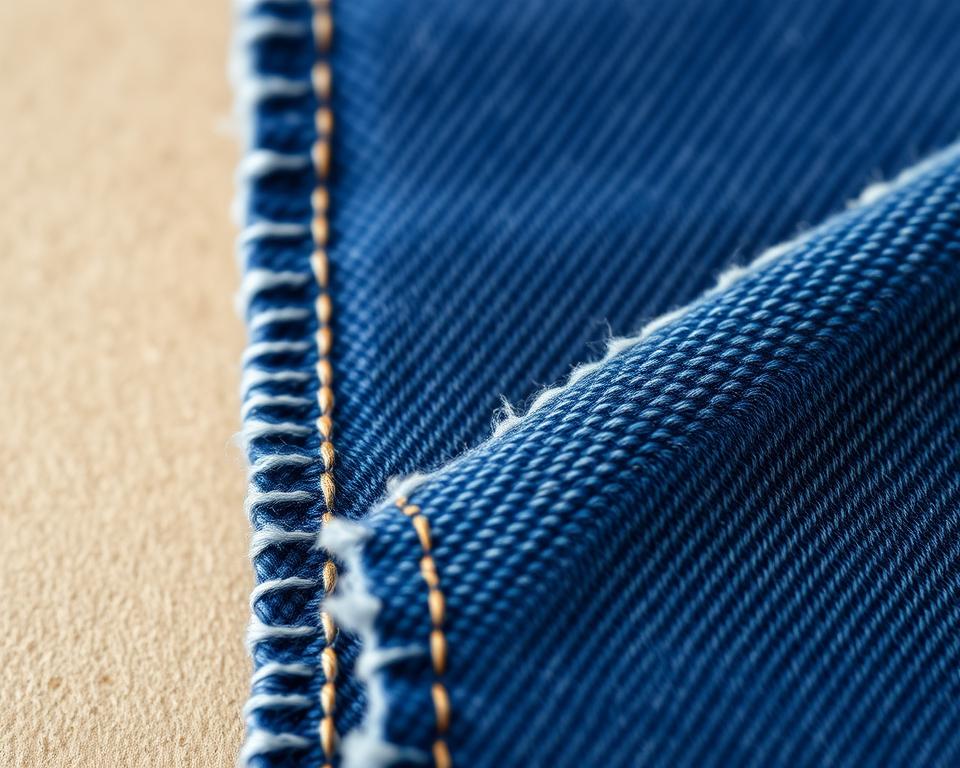The Complete Guide to Selvedge Denim Material
A single pair of vintage Levi’s 501s from the 1940s recently sold for $87,400 at auction. What caused these jeans to outprice a luxury vehicle? It all comes down to their selvedge denim fabrication.
This high-end denim stands for more than simple material. It recalls the era when James Dean donned his 501s in Rebel Without a Cause, and Marlon Brando epitomized cool in The Wild One. These cultural icons didn’t just wear jeans. They chose black selvedge denim fabric wholesale woven on antique shuttle looms.
Craft denim derives its title from the self-finished perimeters that avert fraying. The word “selvedge” fuses “self” and “edge” to depict this singular weaving approach. Differing from factory-made denim, each yard of selvedge denim material requires patience and expertise to craft.
The surface narrates a tale via gentle inconsistencies and organic variations. Each iteration gains personality as the indigo lightens. This personal evolution makes heritage denim special to collectors and fashion enthusiasts alike.
Numerous people assume high-end denim endures beyond ordinary jeans. The truth is more nuanced. Selvedge crafting produces lovely material with tidy edges and robust texture. Yet durability hinges on cotton grade and weight, rather than solely on weaving method. What differentiates artisanal denim is its knack for aging with grace and creating singular fading designs in the long run.
Defining Selvedge Denim Material
Selvedge denim fabric is distinct from regular denim due to its unique construction and finished edges. It’s named for its “self-edge,” a tightly woven band that prevents fraying. This high-grade material signifies allegiance to slow fashion and age-old craft, marking a contrast with mass-made denim.

Decoding Self-Edge Construction
The term “selvedge” is a blend of “self” and “edge,” describing fabric with a clean, finished border. This narrow selvage runs along both sides, removing the requirement for added finishing. Traditional mills produce it in widths of about 30-32 inches, unlike modern denim’s 60-inch width.
Shuttle Looms and Their Unique Fabric Borders
Shuttle-loomed denim’s essence stems from classic weaving machines operating more slowly. They pass one weft yarn across all warp threads in a single sweep. This process yields:
- Organic textural slubs
- A plusher hand-feel versus modern denim
- Firmly locked edges that avoid fraying
- Genuine irregularities prized by denim fans
Selvedge vs. Standard Denim
Regular denim comes from projectile looms firing weft yarns over broader widths. This method leaves loose threads at the edges, needing overlocked seams to prevent fraying. Selvedge denim fabric, however, requires extra time in production. It provides greater longevity and a special style, meriting its loftier price tag.
The Heritage and History of Shuttle-Loomed Denim
The legacy of heritage denim commenced in U.S. textile mills of the 1800s. Shuttle looms played a vital role, crafting cloth with self-finished edges to stop fraying. That approach yielded indigo-dyed denim slowly and painstakingly, guaranteeing each yard was made with precision. Its slender width evolved into a trademark of artisan denim manufacture.
From 19th-Century U.S. Mills to Contemporary Revival
For upwards of a century, American factories leaned on shuttle looms. Labels like Cone Mills and White Oak delivered high-end denim to workwear firms. Come the 1970s, speedier projectile looms dominated, supplanting most shuttle setups. This transition was fueled by demand for lower-cost, mass-made denim. Several historic factories wound down or upgraded, causing vintage looms to languish.
How Japan Revived Selvedge Denim
In the 1980s, Japanese manufacturers revived American shuttle looms. Leading the charge were the Osaka Five brands:
- Studio D’Artisan
- Evisu
- Fullcount
- Warehouse
- Denime
These companies merged American vintage style with Japanese precision. They examined vintage Levi’s patterns and reimagined time-honored indigo-dyed denim feels. By 2000, Japanese makers had overtaken the global artisan denim market.
Relevance of Classic Weaving Now
Shuttle looms yield distinct cloth traits that contemporary machines cannot replicate. This slower method fosters subtle irregularities and fuller indigo soak. Hardcore denim fans treasure these quirks as proof of real craftsmanship.
| Shuttle Loom Features | Modern Loom Features |
|---|---|
| 29-31 inch fabric width | 60+ inch fabric width |
| 3-4 yards per hour | 15-20 yards per hour |
| Natural irregularities | Uniform texture |
| Self-finished edges | Cut edges requiring overlocking |
Crafting Premium Denim with Vintage Looms
Premium denim production kicks off with the steady rhythm of antique shuttle looms. These machines differ from today’s technology. They shuttle yarn across the full width at once, binding edges without further work. This approach guarantees selvedge denim sports a neat, fray-free border.
Old shuttle looms turn out a mere 5 to 6 meters of selvedge denim material each day. That stands in bold contrast to contemporary looms weaving 200 meters. The slower speed benefits the yarn in several ways:
- Less tension on fibers creates a softer hand feel
- Organic irregularities stay put, granting unique texture
- Irregular topography crafts unique fade patterns
- Slim widths (around 29–32 inches) cut down waste
Running these vintage looms demands expert operators. Mill workers adjust tension, monitor rhythm, and perform repairs. Each loom has its own unique character. Many were built in the 1920s and require know-how passed through the ages. This tactile method turns shuttle-loomed denim into an authentic artisan good.
The slim width of dry denim on antique looms offers a real advantage. Pant makers utilize the selvedge edge as the outrigger seam, avoiding waste. This flaunts the cloth’s true craftsmanship. Every bolt carries history, with slight quirks that mass output cannot match.
Differentiating Raw Denim from Selvedge Denim
Many denim enthusiasts confuse raw denim with selvedge denim fabric. This misunderstanding crops up while seeking high-end jeans. The fact is they denote separate facets of denim creation. Understanding this difference guides smarter choices and deeper appreciation of each style’s uniqueness.
Why Selvedge Isn’t Always Raw
Selvedge refers to the weaving method on vintage shuttle looms, creating self-finished edges. Raw denim stands for unwashed textile direct from production. A selvedge raw denim distributor often carries both rinse and dry options. Companies like Naked & Famous craft selvedge jeans, sometimes pre-washed or stretch-infused.
The weaving technique remains the same. Yet, the finishing process changes everything about the fabric’s feel and look.
Choosing Between Washed and Unwashed Denim
Each denim item originates as dry denim before laundering. Factories make both regular and selvedge variants in unwashed form. The main differences are:
- Raw denim forms distinct fade lines with wear
- Rinse-treated denim provides quick comfort and sizing stability
- Sanforized raw stays closer to original measurements after first wash
- Unsanforized versions shrink significantly when soaked
Clearing Up Denim Myths
Raw denim isn’t exclusively shuttle-loomed. Contemporary projectile looms likewise churn out unwashed textile. Their appeal converges since consumers prize longevity, customization, and artistry in both selvedge and raw denim. Both varieties entice denim devotees prepared to spend time for ideal custom fading.
Spotting Genuine Selvedge Denim Traits
If you’re shopping for selvadge raw denim fabric wholesaler, spotting real selvedge denim is essential. It separates you from everyday customers. Real selvedge denim has unique traits that set it apart from regular denim. Knowing these signs guarantees you’re buying true high-end denim.
Spotting the Signature Selvedge ID
The clearest way to spot selvedge denim is viewing the outseam. Cuff your jeans and check the outer-leg seam. Genuine selvedge denim has a clean, finished edge with colored yarns woven into the fabric. This self-finished edge eliminates the need for overlocking stitches found on regular denim.
Rolling your cuffs unveils the selvedge ID, giving your outfit a signature detail. The colored edge yarns run continuously down the outseam, creating that signature look denim enthusiasts adore. By contrast, non-selvedge jeans sport cut edges bound by serger stitches to stop fraying.
Quality Construction Hallmarks
Top-tier premium denim reveals itself by key build features:
- Compact, consistent weave without loose fibers
- Neat selvedge borders lacking extra seams
- Stable colored yarn running the full outseam
- Dense fabric weight typical of shuttle-loom production
Rainbow vs Redline Selvedge Distinctions
Rainbow selvedge uses multiple tinted yarns in the ID, crafting a distinct multicolor trim. Redline selvedge, the iconic type, employs red threads in the ID and hails from classic U.S. mills. These unique selvedge forms carry premium prices thanks to their scarcity and aesthetic allure. Brands often showcase these details in listings, aiding you in spotting genuine heritage denim.
Why Craft Denim Costs More
The cost of artisanal denim often shocks newcomers. Selvedge jeans often cost 3–5× more than factory-made pairs.
Understanding the factors behind these prices reveals the true value of premium denim.
Shuttle looms weave at a much slower pace than modern machines. Though factory looms crank out fabric fast, old shuttle looms manage only 1–2 meters hourly. This deliberate procedure turns a roll of heritage denim into a multi-day project.
The narrow width of selvedge fabric adds to the cost. As opposed to 60-inch standard denim, shuttle-loom premium denim is merely 28–32 inches across. Such narrowness demands extra planning and precision cutting to optimize usage.
Artisan denim is produced in limited lots. Suppliers like Okayama’s White Oak and Kuroki emphasize quality rather than scale. They staff master artisans who manage each stage:
- Hand-checking yarn tension
- Adjusting loom settings for each fabric type
- Inspecting every meter for flaws
- Managing rope-dyeing processes that take weeks
These artisans treat denim-making like fine art. They play with distinct yarns and hone indigo-dye recipes handed down through the lineage. Backing heritage denim helps mills safeguard textile legacies and artisans devoted to their work.
Wholesale Choices for Black Selvedge Denim Fabric
The premium denim market has grown beyond Japan’s traditional mills. American manufacturers now challenge, supplying multiple black selvedge denim wholesale options. Finding top suppliers means knowing quality indicators and authentic fabric sources.
Identifying Quality Wholesalers and Mills
Quality suppliers emphasize heritage weaving and a deep passion for craftsmanship. Hunting for a selvedge raw denim wholesaler? Seek out mills still running shuttle looms. These suppliers offer detailed fabric specs, including weight, weave pattern, and dye methods.
Leading Gold Selvedge Denim Mills
Gold selvedge mills emphasize luxe-colored edge yarns, enhancing denim prestige. Leading mills produce these specialty fabrics in limited quantities, attracting boutique brands. The gold thread ID gives these fabrics a unique finish, distinguishing them from standard options.
Sourcing Specialty Fabrics Like Nep Denim
Specialty fabrics like nep denim need specific sourcing channels. Nep denim shows deliberate specks for standout aesthetics. Partnering directly with mills guarantees availability of these niche weaves.
| Fabric Type | Minimum Order | Lead Time | Price Range per Yard |
|---|---|---|---|
| Black Selvedge | 500 yards | 6-8 weeks | $12-18 |
| Gold ID Selvedge | 300 yards | 8-10 weeks | $15-22 |
| Nep Denim | 400 yards | 10-12 weeks | $14-20 |
Popular Selvedge Styles and Fabric Variations
Selvedge denim’s realm extends past plain indigo. Now, suppliers craft diverse textures and motifs. They highlight the adaptability of shuttle-loom craftsmanship. From subtle surface variations to bold visual patterns, these fabrics offer unique character that develops beautifully with wear.
Understanding Slub Denim Texture
Slub denim’s unique textured surface originates from thick-thin yarn variations. These yarns have thick and thin spots, creating a fabric surface with natural variations. Woven on shuttle looms, they form slub-textured selvedge that fades unpredictably.
Each slub denim jean yields its own one-off wear pattern. The raised slubs fade differently than the flat parts, ensuring no two pairs look alike.
Herringbone Selvedge Traits
Herringbone selvedge cloth sports a zigzag weave reminiscent of fish skeletons. This weave creates diagonal lines that shift direction at regular intervals. The pattern adds visual interest and gives the fabric extra strength.
Popular brands like Iron Heart and The Strike Gold regularly use this weave for their premium collections.
Striped Denim and Other Unique Weaves
Striped denim uses alternating threads to form vertical or horizontal stripes. Factories weave these patterns by switching colored threads as they work. Some popular variations include:
- Hickory stripe with alternating indigo and white
- Railroad stripe featuring thin pinstripes
- Wabash stripe with printed dots over stripes
| Fabric Type | Visual Pattern | Fade Characteristics |
|---|---|---|
| Slub Denim | Bumpy, irregular surface | High contrast, uneven fading |
| Herringbone | Zigzag diagonal lines | Subtle vertical streaking |
| Striped Denim | Alternating color bands | Pattern remains visible after fading |
Caring for Your Heritage Denim Investment
Your heritage denim calls for tailored care to grow its special character. Unlike standard jeans, raw and dry denim morph through use. They craft individual fade narratives reflecting your life.
Your first few wears in artisan denim might feel firm and odd. This is normal. The material requires wear to relax and hug your silhouette. Some wearers hasten the softening by donning them in the shower or squatting when damp. Others opt for a gradual, more organic break-in.
Raw denim yields its prime fades if you delay washing. Natural skin oils and daily movement produce whiskers at knees and honeycombs on the back. Many wearers wait six months for the first wash, and some even a year. This patience rewards you with high-contrast fades unique to your movement patterns.
At wash time for dry denim, invert and launder in cold water. Skip the spin cycle and hang dry away from direct sunlight. Others opt for gentle hand-wash in a bathtub using a soft detergent. Steer clear of hot water and tumble drying, which may shrink and dull fades.
Your denim investment appreciates with correct maintenance. Every wear layers character, ensuring your jeans are uniquely yours. The rigid start transforms into a comfortable second skin that reflects your lifestyle and movement patterns.
Where to Find Quality Indigo-Dyed Denim
Selvedge denim’s comeback has created fresh opportunities for fans. Major retailers now carry indigo-dyed denim alongside specialty stores focused on premium denim and slow fashion. This allows consumers to find authentic selvedge options at various price points, catering to different budgets and styles.
Levi’s retails the 501 Original Fit Selvedge at $148, spreading heritage craftsmanship further. Uniqlo provides Selvedge Straight Jeans at just $50, appealing to those who value style and affordability. For those looking for higher-end options, Buck Mason features Japanese Loom State Selvedge Full-Saddle Jeans at $248. Iron Heart pushes premium denim further with its 634s-18 Vintage Denim Jeans at $385 via Self Edge.
U.S. labels such as Todd Snyder and Buck Mason now rival Japanese experts in the selvedge arena. These brands recognize the importance of heritage weaving techniques and quality in slow fashion. Online or offline, good indigo-dyed denim is easier than ever for American shoppers devoted to genuine craft.


